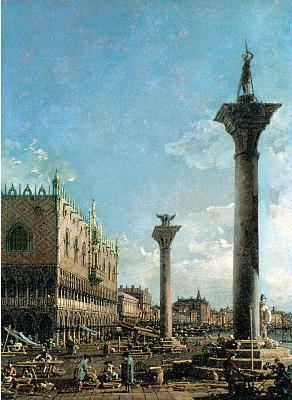Canaletto (Giovanni Antonio Canal)
Italian, 1697-1768 VENICE: THE RIVA DEGLI SCHIAVONI TO THE EAST
SN 187, Oil on canvas, 1760s
From "The Pages".
ARTIST:
Giovanni Antonio Canal, called Canaletto, is acclaimed the most distinguished view-painter
of the 18th c. He was draftsman, painter, etcher. Born in Venice, he was trained by his
father to paint theater scenery; he worked on sets for Vivaldi & Scarlatti operas,
spending some time in Rome. Tiring of the milieu, he returned to Venice & began to
paint vedute (actual views) and capriccios (imagined scenes). He had to have seen the work
of Luca Carlevaris, whom he soon outshone in popularity. During scenery painting in Venice
theaters, he had developed a friendship with Marco Ricci which influenced his later work;
the ruin paintings of Giovanni Panini (1691-1765) were also influential.
After 1720 his association with Joseph Smith, an English banker and shipping agent, &
(later) consul, secured commercial success. In 1746, prompted by a decline in Venetian
commissions he went to England, where he lived until 1755. There he gained fame with his
views of the Thames, Westminster, and Whitehall. [Today The British Royal Collection has
the largest group of his paintings & drawings, well over 100.] Canaletto returned to
Venice where he lived and worked until his death in 1768 at the age of 71. |
|
 |
SUBJECT:
This veduta [pendant to SN 186, Venice: P. San Marco Seen From Campo San Basso] is
characteristic of Canaletto’s late
view paintings. The two granite columns dedicated to St Mark and the winged lion of Venice
grab our attention; both were brought back from Tyre in 1170. [In earlier times, there was
public gambling between those pillars, & it was also the place for executions, handy
to the Doge’s dungeons. Venetians today still consider it unlucky to walk between the
columns!] The teeming business of the day is carried on in covered stalls on the Molo (the
Piazzetta’s waterfront). The Palazzo Ducale (Doge’s palace) rises on the left.
In the distance various buildings curve with the Riva, fronting the Grand Canal.
PAINTING:
Absent from this work is the plein aire of the Canaletto vedute of the 1740s-50s. This is
a more mannered style, with artificial “spot-lighting” instead of the infusion
of sunlight that marked the period when Canaletto worked in the open air. The perspective
shows his draftsman’s skill: the Riva curves to the right, so the buildings in the
distance are on the same curve, following the waterline; therefore they do not grow
continually smaller, as you would expect. Canaletto’s selection of elements &
rendering of detail reflect his theatrical training & justify his reputation.
HISTORIC CONTEXT: The 18th c. is characterized as the Age of Reason, & the beginning
of the modern age. It was also the age of the Grand Tour for young Englishmen, a ready
market for view-painters. Another influence on Canaletto’s life was the War of
Austrian Succession, which reduced the flow of visitors to Venice, thereby demand for his
pictures – hence the move to England.
Museum Label:
Venice: The Riva Degli Schiavoni Towards the East
1760s
Artist: Giovanni Antonio Canal, called Canaletto
Italian, 1697-1768, active in Venice and London
Oil on canvas, FRAMED (Framed): 21 1/4 x 17 1/4 x 3 3/4 in. (54 x 43.8 x 9.5 cm) 14 3/4 x
10 1/8 in. (37.5 x 25.7 cm)
The great Venetian view (vedute) painter, Canaletto, employs steep perspective in this
view of the Riva degli Schiavoni, a promenade adjacent to the Canale di San Marco leading
to the famed Piazza San Marco, which Canaletto documents in the pendant to this work. The
details of the buildings and monuments are subordinated to the general description of the
wonderful shapes and character of the public spaces of the city.
Bequest of John Ringling, 1936, SN187
ringlingdocents.org
|